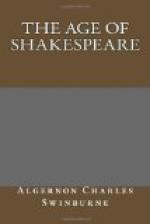In that prodigious monument of learning and labor, Mr. Fleay’s Biographical Chronicle of the English Drama, the common attribution of these two plays to Heywood is impeached on the aesthetic score that “they are far better than his other early work.” I have carefully endeavored to do what justice might be done to their modest allowance of moderate merit; but whether they be Heywood’s or—as Mr. Fleay, on apparent grounds of documentary evidence, would suggest—the work of Chettle and Day, I am certainly rather inclined to agree with the general verdict of previous criticism, which would hardly admit their equality and would decidedly question their claim to anything more than equality of merit with the least admirable or memorable of Heywood’s other plays. Even the rough-hewn chronicle, “If you know not me you know nobody,” by which “the troubles of Queen Elizabeth” before her accession are as nakedly and simply set forth in the first part as in the second are “the building of the Royal Exchange” and “the famous victory” over the Invincible Armada, has on the whole more life and spirit, more interest and movement, in action as in style. The class of play to which it belongs is historically the most curious if poetically the least precious of all the many kinds enumerated by Heywood in earnest or by Shakespeare in jest as popular or ambitious of popularity on the stage for which they wrote. Aristophanic license of libel or caricature, more or less ineffectually trammelled by the chance or the likelihood of prosecution and repression, is common under various forms to various ages and countries; but the serious introduction and presentation of contemporary figures and events give




